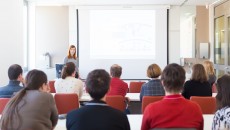As part of a weekend retreat organized by the Rotary clubs of Lebanon, I once delivered an introductory session on public speaking to a highly energetic crowd of university students. The session took place in a hotel ballroom in the picturesque town of Ehden, it was packed with more than 130 attendees and half of them had their backs turned to me.
Circular tables are great for social functions, especially weddings. They can comfortably fit up to 10 people and they allow for great conversations. But it’s not the same story when it comes to delivering a training workshop or facilitating a group discussion: with your primary objective being to connect with your audience, circular tables make it extremely hard to do so.
Think about it: even if half the attendees in the room turn their heads, shoulders, and chairs to make eye contact with you, they would be feeling uncomfortable doing so. You’re already facing an uphill battle as a speaker trying to win over the attention of your audience; do you really need to add another obstacle that can be easily avoided?
Part of your responsibility as a trainer or public speaker is to ensure a comfortable and memorable experience for your audience. This includes choosing and planning a seating arrangement that is functional both to the audience and to you. So what are the venue layouts typically used for workshops and training sessions?
- The auditorium style: the least engaging of arrangements, where speakers are usually stranded on a stage and distanced from their audience.
- The classroom style: a more flexible arrangement, where movement along the aisles allows for more interaction with an audience.
- The U-shape style: an all-time favorite for trainers, allowing for easy navigation and heightened engagement with attendees.
But what if there’s nothing to be done? What if the event organizer or the venue cannot accommodate any seating arrangement of yours? Then you’d have to double your efforts at trying to engage with your audience. No need to verbally acknowledge the shortcomings of the seating layout: just bring your A game to the session. Speak louder. Move around the room. Ask the audience to move closer to the stage. Engage with as many attendees as possible. Speak out of different locations around the room. And create memorable drama for them to remember.
Maybe that’s why I hold such a fond memory of my personal experience at the Rotary weekend retreat. It was a glorious day. A day where the infamous circular table was defeated.


